Anatomy
Arthritis
Partial Knee Replacement
Total Knee Replacement
What to Expect on Surgery Day
Post Operative Care
Knee Rehabilitation
Non-Surgical Alternatives
Life After Knee Replacement
Knee replacement surgery is a complex procedure, and physical knee rehabilitation is crucial to a full recovery. In order for you to meet the goals of total knee surgery, you must take ownership of the rehabilitation process and work diligently on your own, as well as with your physical therapist, to achieve optimal clinical and functional results. The knee rehabilitation process following total knee replacement surgery can be quite painful at times.
Your Orthopedic Surgeon and/or Physical Therapist will most likely assign a specific protocol to you, based on your rehabilitation needs. The following protocol is meant only to give you an idea of the kind of exercises you might do during rehabilitation. When in doubt about an exercise, follow the protocol outlined by your Surgeon and/or Physical Therapist.
Early Rehabilitation
Your knee rehabilitation program begins in the hospital after surgery. Early goals of knee rehabilitation in the hospital are to reduce knee stiffness and maximize post-operative range of motion as well as to help you get ready for discharge. The following steps may be taken to help maximize your range of motion following surgery.
- Strict adherence to the CPM protocol as prescribed by your surgeon
- Early physical therapy (day 1 or 2) to begin range of motion exercises and walking program
- Edema control to reduce swelling (ice, compression stocking, and elevation)
- Adequate pain control so you can tolerate the rehabilitation regimen
Your outpatient knee rehabilitation program will consist of a variety of exercises designed to help you regain range of motion in the knee and build strength in the muscles which support the knee. You will follow an advanced strengthening program, adding weights as tolerated. A stationery cycle and walking program will be used to help increase range of motion and stamina, and an aquatic therapy program may be added as well.
Typical Home Exercises
Instructions in your home exercise program may include the exercises shown below. Consult your therapist regarding the appropriateness of the exercises and the number of reps.
Ankle Pumps: Flex ankle up and down.
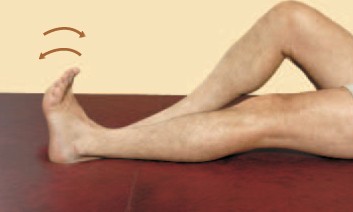
Quadriceps sets: Tighten thigh muscles and Hold for five seconds.
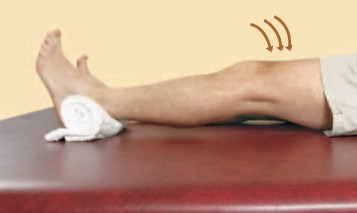
Heel slides: Flex your hip and knee. Return knee to the straight position.
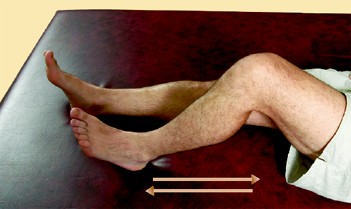
Leg lifts: Raise leg six inches above the floor, keeping knee straight.
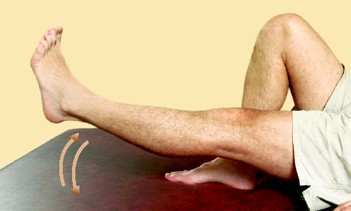
Knee extension: Place a pillow under your knee. Lift your foot off the mat.
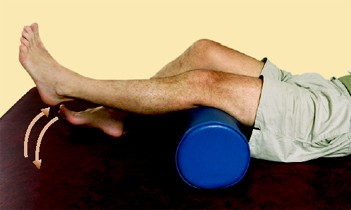
Knee flexion stretch: Place a towel under your heel. Pull your knee towards your chest. Hold your knee in this flexed position for 15-20 seconds. Return knee to the straight position.
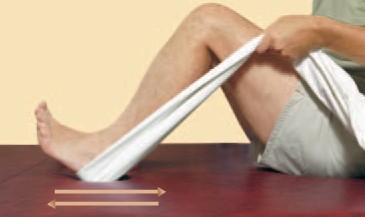
At Home
There are several things you can do at home to make your knee rehabilitation more successful. First of all, do the home exercise program as prescribed by your physical therapist. Next, follow these suggestions for daily activities:
- Sitting: Use a chair with arms to help you rise to a standing position. Avoid sitting for longer than an hour if possible. If you must sit for a longer time, elevate the foot to avoid swelling.
- Walking: Do not put weight through the joint until you’ve been cleared to do so by your surgeon.
- Lifting: Do not lift more than ten pounds.
- Showering: Showering is preferable to bathing because of difficulties getting in and out of the tub.
- Exercising: Do the exercises that were recommended by your doctor and physical therapist. Go to physical therapy as prescribed and get advice from your therapist as to whether you’re doing the exercises correctly.
- Getting into a car and driving: Get into a car by sitting on the edge of the seat, then pulling in the legs and turning to face forward. Driving is usually not recommended for the first six weeks post-op. Talk with your surgeon about driving sooner.
-
Long-Term Knee Rehabilitation Goals
Once you’ve completed your knee rehabilitation therapy, you can expect a range of motion from 100-120 degrees of knee flexion, mild or no pain with walking or other functional activities, and independence with all activities of daily living.
Contents Courtesy of www.knee-replacement-info.com